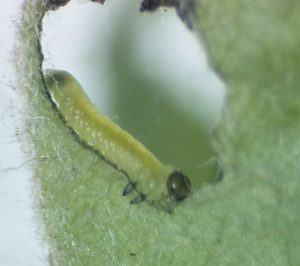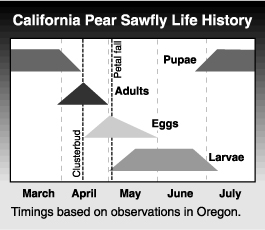by Phil VanBuskirk, originally published 1993
Pristophora abbreviata (Hartig) (Hymenoptera:Tenthredinidae)
California pear sawfly has historically been only a minor pest on pear. It has been found primarily in abandoned orchards. Although the common names are similar, it should not be confused with pear sawfly, Caliroa cerasi. C. cerasi has a slug-like larva, whereas the larva of P. abbreviata resembles a caterpillar.
Hosts
It is primarily a pest of pear.
Life stages

Egg
The egg is small, oval and a translucent white.
Larva
The mature larva is bright green, about 1/2 inch (13 mm) long and has seven pairs of prolegs. Unlike the pear sawfly, the larva of the California pear sawfly resembles a caterpillar (see Sawflies in general).
Adult
The adult is black with yellow marks on the prothorax and is about 1/4 inch (7 mm) long.
Life history
Adult California pear sawflies emerge in early spring. After mating, females deposit their eggs in leaf tissue, usually around the edges of the leaves. Larvae emerge at petal fall or soon after and feed on the leaves in a characteristic circular pattern, leaving holes along the edges and within the leaves. They remain on the tree, eating only leaves, until April and May. Mature larvae fall to the ground and enter the soil where they pupate and overwinter. There is only one generation per year.
Damage
Heavy populations of larvae can consume entire leaves, leaving only the midribs. In large enough numbers, California pear sawflies can defoliate an orchard in a matter of weeks. They do not attack fruit.
Monitoring
Soon after petal fall inspect the leaves for small holes. Sample 100 leaves, one leaf per tree, throughout each 20-acre block. Take no action if fewer than 6 leaves are infested. If between 6 and 25 leaves are infested, continue monitoring weekly for increases in population or damage. If more than 25 leaves are infested, consider control.
Management
Most years, insecticides applied for codling moth and other orchard pests control California pear sawfly. However, it could become a problem where orchardists delay or eliminate codling moth controls. Use of mating disruption in place of insecticides to control codling moth may allow California pear sawfly populations to increase. If insecticide applications for codling moth are delayed until 2 to 4 weeks after petal fall, pear sawfly numbers could be high enough to damage leaves, and within a few weeks they can defoliate an orchard.
If mating disruption is used to control codling moth, and California pear sawfly needs to be controlled, an organophosphate material can be used. Use low rates to avoid disrupting natural enemies in the orchard.
